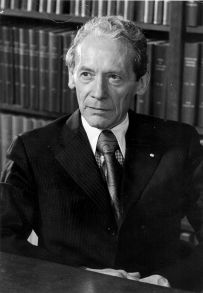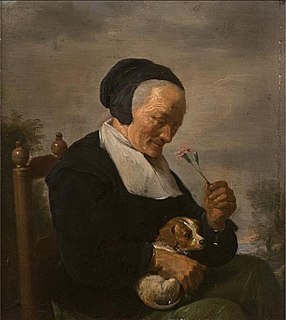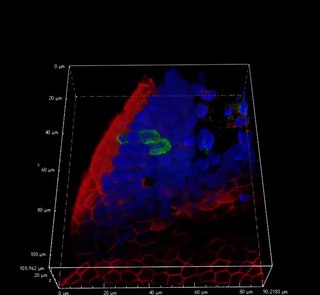
A pulmonary alveolus also known as an air sac or air space is one of millions of hollow cup-shaped cavities in the lungs where oxygen is exchanged for carbon dioxide. Alveoli make up the functional tissue of the lungs known as the lung parenchyma, which takes up 90 percent of the total lung volume.

The epiglottis is a leaf-shaped flap in the throat that prevents food from entering the windpipe and the lungs. It stays open during breathing, allowing air into the larynx. During swallowing, it closes to prevent aspiration of food into the lungs, forcing the swallowed liquids or food to go along the esophagus toward the stomach instead. It is thus the valve that diverts passage to either the trachea or the esophagus.
A chemoreceptor, also known as chemosensor, is a specialized sensory receptor cell which transduces a chemical substance to generate a biological signal. This signal may be in the form of an action potential, if the chemoreceptor is a neuron, or in the form of a neurotransmitter that can activate a nerve fiber if the chemoreceptor is a specialized cell, such as taste receptors, or an internal peripheral chemoreceptor, such as the carotid bodies. In physiology, a chemoreceptor detects changes in the normal environment, such as an increase in blood levels of carbon dioxide (hypercapnia) or a decrease in blood levels of oxygen (hypoxia), and transmits that information to the central nervous system which engages body responses to restore homeostasis.

Sweetness is a basic taste most commonly perceived when eating foods rich in sugars. Sweet tastes are generally regarded as pleasurable, except when in excess. In addition to sugars like sucrose, many other chemical compounds are sweet, including aldehydes, ketones, and sugar alcohols. Some are sweet at very low concentrations, allowing their use as non-caloric sugar substitutes. Such non-sugar sweeteners include saccharin and aspartame. Other compounds, such as miraculin, may alter perception of sweetness itself.

Charles Philippe Leblond was a pioneer of cell biology and stem cell research and a Canadian former professor of anatomy. Leblond is notable for developing autoradiography and his work showing how cells continuously renew themselves, regardless of age.
In medicine and anatomy, the special senses are the senses that have specialized organs devoted to them:
Gut-associated lymphoid tissue (GALT) is a component of the mucosa-associated lymphoid tissue (MALT) which works in the immune system to protect the body from invasion in the gut.

Uteroglobin, also known as secretoglobin family 1A member 1 (SCGB1A1), is a protein that in humans is encoded by the SCGB1A1 gene.
Chemesthesis is the chemical sensitivity of the skin and mucous membranes. Chemesthetic sensations arise when chemical compounds activate receptors associated with other senses that mediate pain, touch, and thermal perception. These chemical-induced reactions do not fit into the traditional sense categories of taste and smell.

The subcommissural organ (SCO) is one of the circumventricular organs of the brain. It is a small glandular structure that is located in the posterior region of the third ventricle, near the entrance of the cerebral aqueduct.

A taste receptor is a type of cellular receptor which facilitates the sensation of taste. When food or other substances enter the mouth, molecules interact with saliva and are bound to taste receptors in the oral cavity and other locations. Molecules which give a sensation of taste are considered "sapid".

Taste receptor type 2 member 1 (TAS2R1/T2R1) is a protein that in humans is encoded by the TAS2R1 gene. It belongs to the G protein-coupled receptor (GPCR) family and is related to class A-like GPCRs, they contain 7 transmembrane helix bundles and short N-terminus loop. Furthermore, TAS2R1 is member of the 25 known human bitter taste receptors, which enable the perception of bitter taste in the mouth cavity. Increasing evidence indicates a functional role of TAS2Rs in extra-oral tissues.
Dental pertains to the teeth, including dentistry. Topics related to the dentistry, the human mouth and teeth include:
Solitary chemosensory cells (SCCs) are isolated elements located in epithelia of the apparatuses of endodermic origin. In the aquatic vertebrates, SCCs are also present in the skin. In oral cavity, SCCs precedes the development of taste buds. For long time, SCCs were considered to be typical of aquatic vertebrates. Recently, these elements were also demonstrated in mammals.
Chemosensory clusters are aggregates formed by a small number of chemoreceptor cells with characteristics similar to those found in the taste cells of the oropharyngeal cavity. The chemosensory clusters are similar to the taste buds but are smaller, resembling the developing taste buds. Chemosensory clusters are located in the larynx distally to the portion in which are present laryngeal taste buds and proximally to the region in which solitary chemosensory cells are found. Rarely, chemosensory clusters may be found in the distal portion of the airway.

The gustatory nucleus is the rostral part of the solitary nucleus located in the medulla. The gustatory nucleus is associated with the sense of taste and has two sections, the rostral and lateral regions. A close association between the gustatory nucleus and visceral information exists for this function in the gustatory system, assisting in homeostasis - via the identification of food that might be possibly poisonous or harmful for the body. There are many gustatory nuclei in the brain stem. Each of these nuclei corresponds to three cranial nerves, the facial nerve (VII), the glossopharyngeal nerve (IX), and the vagus nerve (X) and GABA is the primary inhibitory neurotransmitter involved in its functionality. All visceral afferents in the vagus and glossopharyngeal nerves first arrive in the nucleus of the solitary tract and information from the gustatory system can then be relayed to the thalamus and cortex.

The sense of smell, or olfaction, is the special sense through which smells are perceived. The sense of smell has many functions, including detecting hazards, and pheromones, and plays a role in taste.
The parabrachial nuclei, also known as the parabrachial complex, are a group of nuclei in the dorsolateral pons that surrounds the superior cerebellar peduncle as it enters the brainstem from the cerebellum. They are named from the Latin term for the superior cerebellar peduncle, the brachium conjunctivum. In the human brain, the expansion of the superior cerebellar peduncle expands the parabrachial nuclei, which form a thin strip of grey matter over most of the peduncle. The parabrachial nuclei are typically divided along the lines suggested by Baxter and Olszewski in humans, into a medial parabrachial nucleus and lateral parabrachial nucleus. These have in turn been subdivided into a dozen subnuclei: the superior, dorsal, ventral, internal, external and extreme lateral subnuclei; the lateral crescent and subparabrachial nucleus along the ventrolateral margin of the lateral parabrachial complex; and the medial and external medial subnuclei

Tuft cells are chemosensory cells in the epithelial lining of the intestines. Similar tufted cells are found in the respiratory epithelium where they are known as brush cells. The name "tuft" refers to the brush-like microvilli projecting from the cells. Ordinarily there are very few tuft cells present but they have been shown to greatly increase at times of a parasitic infection. Several studies have proposed a role for tuft cells in defense against parasitic infection. In the intestine, tuft cells are the sole source of secreted interleukin 25 (IL-25).

Reinhard F. Stocker is a Swiss biologist. He pioneered the analysis of the sense of smell and taste in higher animals, using the fly Drosophila melanogaster as a study case. He provided a detailed account of the anatomy and development of the olfactory system, in particular across metamorphosis, for which he received the Théodore-Ott-Prize of the Swiss Academy of Medical Sciences in 2007, and pioneered the use of larval Drosophila for the brain and behavioural sciences.











